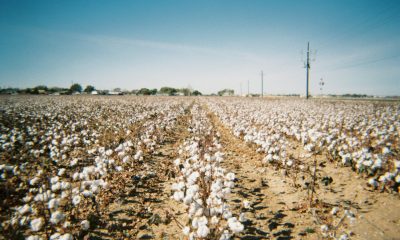Featured
Why The Trade Is Still Worried About Cotton Demand Moving Forward
Cotton closed lower last week and made new lows for the move on renewed strength in the US Dollar. Trends remain down on the charts. Demand remains a question mark at this time even with the reduced harvest. Traders are worried about a global recession and demand in that recession. Production is very short.

Wheat: Wheat markets were lower last week as the US Dollar moved higher. Concern about Russian intentions with the Black Sea grain export corridor continued. Russia has called for new recruits of at least 300,000 men for the war and threatened once again to use nuclear weapons to get its way in Ukraine. Those countries still need to get the Wheat out through Black Sea ports, but so far this has not been a problem. Russia has threatened to cut off exports from Ukraine unless it can have more exports, too, and as it tries to force its will on Ukraine. Russia now appears to be losing the war and could do something rash to try to hold things together. The demand for US Wheat still needs to show up and right now there is no demand news to help support futures. Europe is too hot and dry and the US central and southern Great Plains have also been too hot and dry. Planting and initial emergence could be affected. Dry weather has affected Indian production as well.
Weekly Chicago Soft Red Winter Wheat Futures

Weekly Chicago Hard Red Winter Wheat Futures
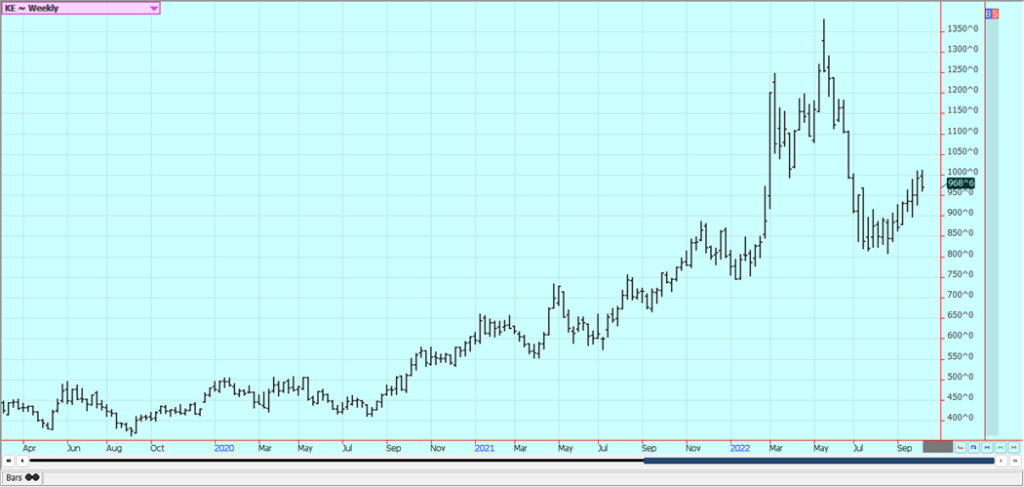
Weekly Minneapolis Hard Red Spring Wheat Futures
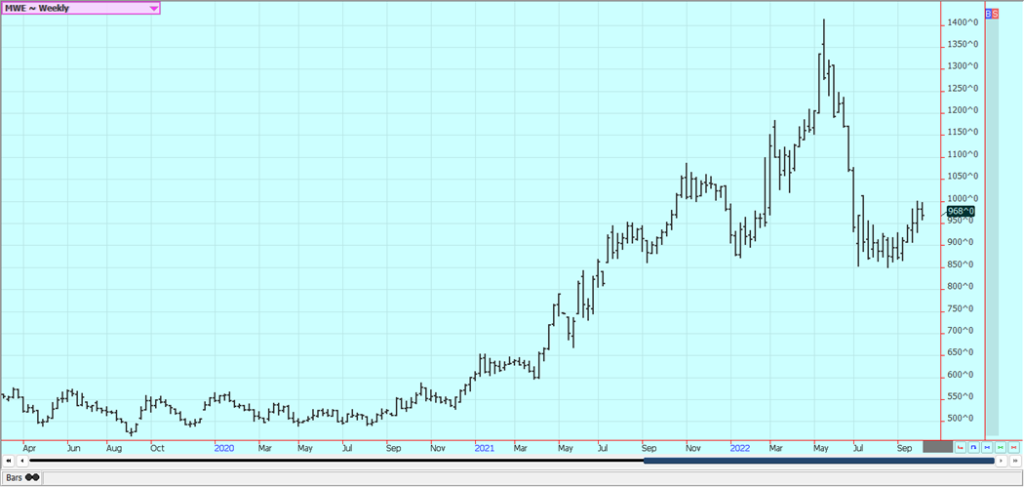
Corn: Corn closed higher last week with strength in petroleum values despite the US Dollar rallying and concerns about low river levels on the Mississippi. The river is low due to the dry conditions seen in most of the central parts of the US and there are no forecasts for an improvement soon. Barge traffic has been reduced and could be stopped soon unless the river levels improve. World petroleum values soared last week as OPEC and Russia moved to cut production in an effoft to keep prices high. The OPEC move could create a lot of new demand for Ethanol and give the processors a nice margin. The harvest comes closer in the US and it is expected that harvest selling could limit any additional upside moves in the market. A sideways trend is more likely than any major moves up or down. The cash market has been strong as the trade is worried about the availability of US Corn in the short run and Ukraine Corn overall. The demand side will need to be watched as Corn demand needs to hold to keep lower ending stocks estimates in play. There are increasing concerns about demand with the Chinese economic problems caused by the lockdowns creating the possibility of less demand as South America has much better crops this year to compete with the US for sales. Export demand in general has been slow so far this year. Ending stocks estimates could be very tight for the coming year if the crop projections hold true. Initial yield reports suggest that total production could be close to the USDA September estimates but lower production is anticipated by some traders as the harvest expands and more yield reports are heard.
Weekly Corn Futures

Weekly Oats Futures

Soybeans and Soybean Meal: Soybeans and the products were higher on Friday but Soybeans and Soybean Meal were both lower for the week as the US Dollar rallied and on concerns about low river levels on the Mississippi. The river is low due to the dry conditions seen in most of the central parts of the US and there are no forecasts for an improvement soon. Barge traffic has been reduced and could be stopped soon unless the river levels improve. The daily Soybeans charts show that Soybeans trends are still down. The trade worried about international weather and supply. Demand remains an issue for the market to contend with. The trade is worried about demand due to a lack of Chinese interest caused by the Covid lockdowns there and in part by the stronger US Dollar. Brazil is still offering and South America as a whole are expected to produce a very big crop later this year for harvest next Spring. However, a third year of La Nina as predicted by meteorologists could cut the production potential. US production ideas remain strong after mostly good weather in August. Basis levels are still strong in the Midwest. There are still renewed Chinese lockdowns and there are fears that China has been importing less as a result.
Weekly Chicago Soybeans Futures:
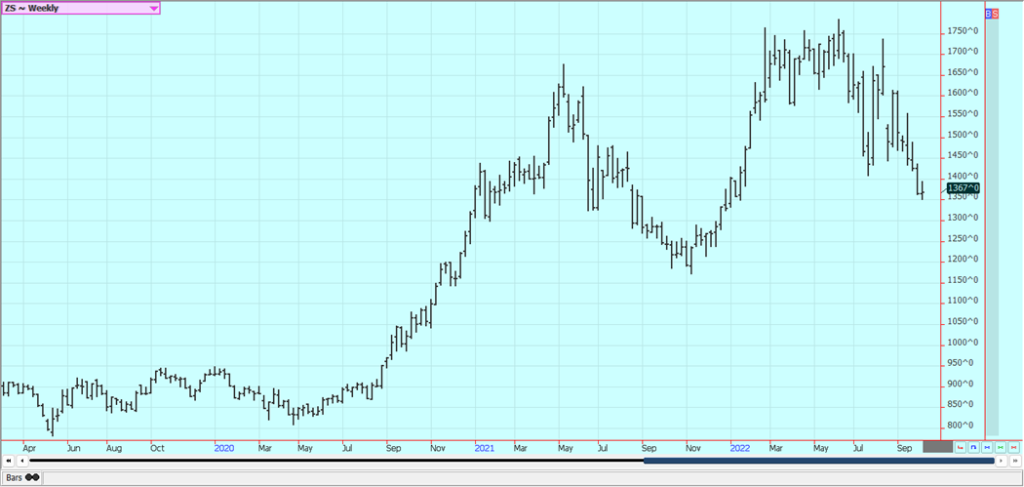
Weekly Chicago Soybean Meal Futures
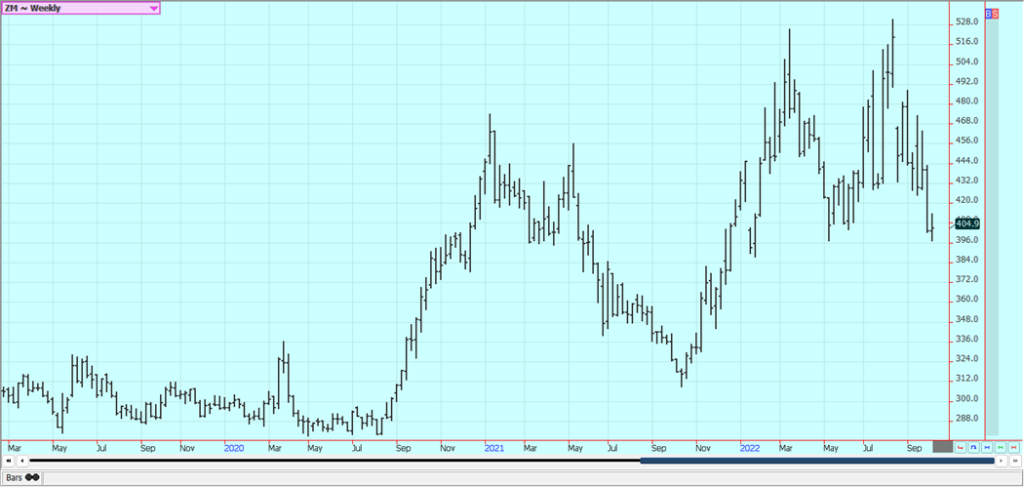
Rice: Rice was lower last week as the harvest pressure continued. The weekly charts show that futures are near some big support areas. Harvest progress is now rapid in Arkansas, the largest Rice producing state, and yields and quality are reported to be very strong. Mississippi is also at harvest with much more mixed results. Some producers are getting done with harvesting in Texas as well as in southern Louisiana. Yield reports have been generally good in Louisiana and quality reports are generally good. Yield and quality have been up and down in Texas.
Weekly Chicago Rice Futures
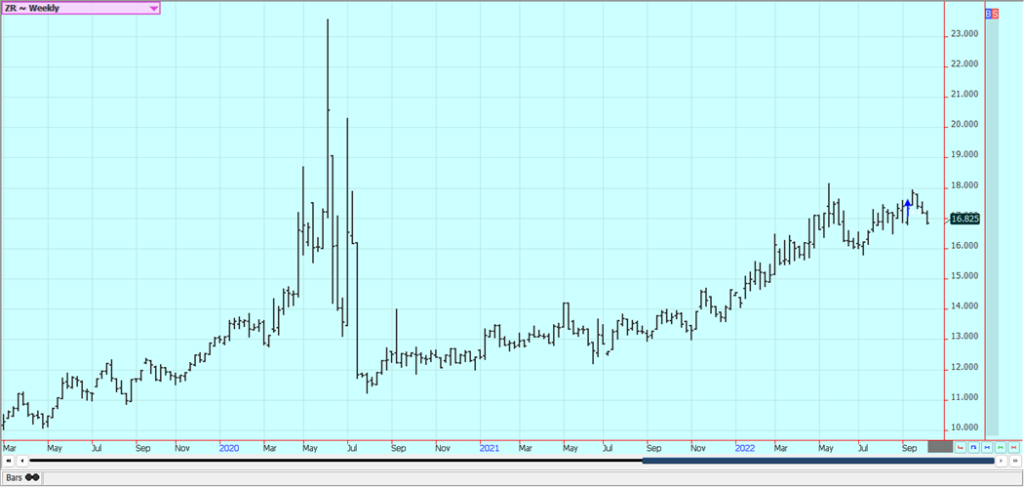
Palm Oil and Vegetable Oils: World vegetable oils were higher in response to news that OPEC and Russia would curtail production in an effort to keep prices high. That effort should result in increased demand for Ethanol and bio fuels. Palm Oil was also higher on ideas of reduced ending stocks for last month. There are still ideas of bigger production and less demand, but the private sources reported a big increase in demand in its reports released covering last month. Ideas are that supply and production will be strong, but demand ideas are now weakening and the market will continue to look to the private data for clues on demand and the direction of the futures market. That data has been strong this month. Canola was higher last week. The Canola harvest approaches. Some of the rally came on continued cash market strength before the harvest. The Canola growing conditions are much improved and production estimates are higher for the year. The market is still short of Canola in the near term due to the reduced production of last year.
Weekly Malaysian Palm Oil Futures
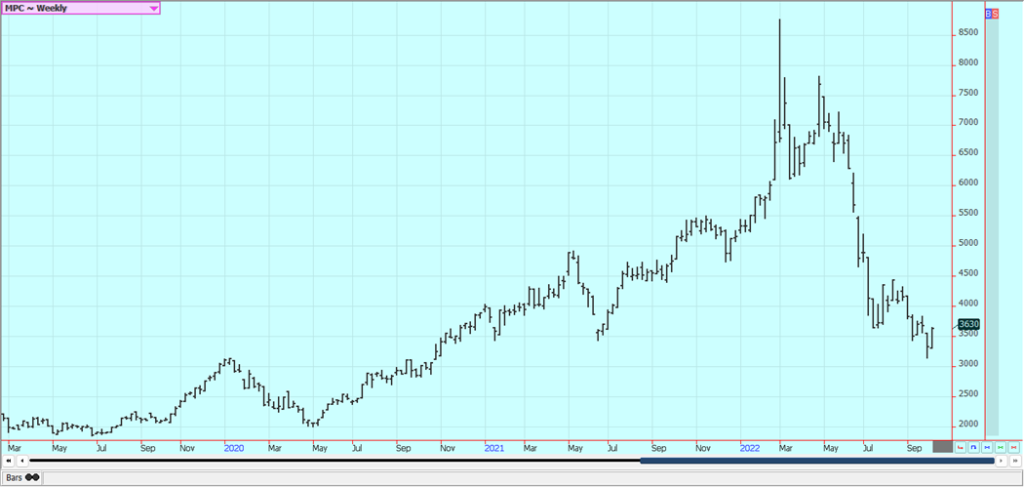
Weekly Chicago Soybean Oil Futures

Weekly Canola Futures:
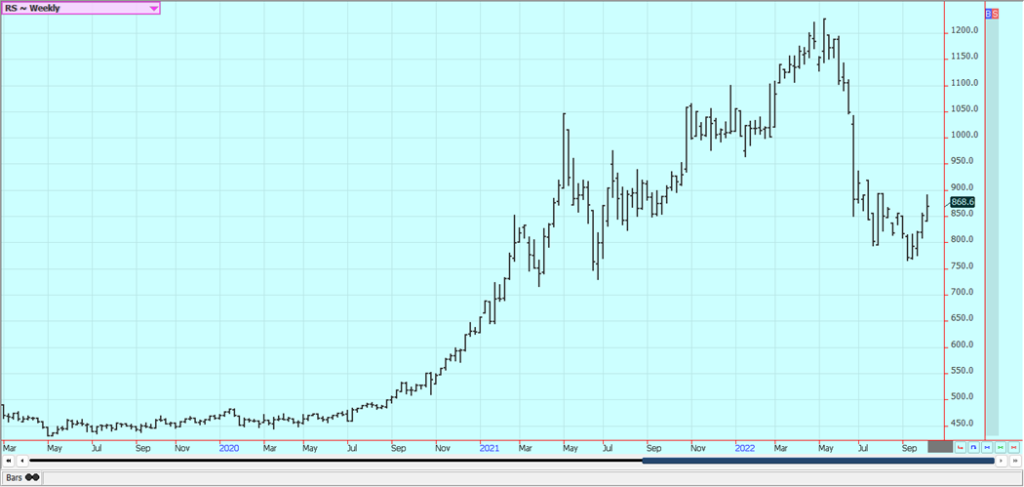
Cotton: Cotton closed lower last week and made new lows for the move on renewed strength in the US Dollar. Trends remain down on the charts. Demand remains a question mark at this time even with the reduced harvest. Traders are worried about a global recession and demand in that recession. Production is very short. The harvest is appearing in the market, and the market is preparing for it with sideways to lower prices. The trade is still worried about demand moving forward due to recession fears and Chinese lockdowns but is also worried about total US production potential. It is possible that the continued Chinese lockdowns will continue to hurt demand for imported Cotton for that country and that a weaker economy in the west will hurt demand from the rest of the world.
Weekly US Cotton Futures
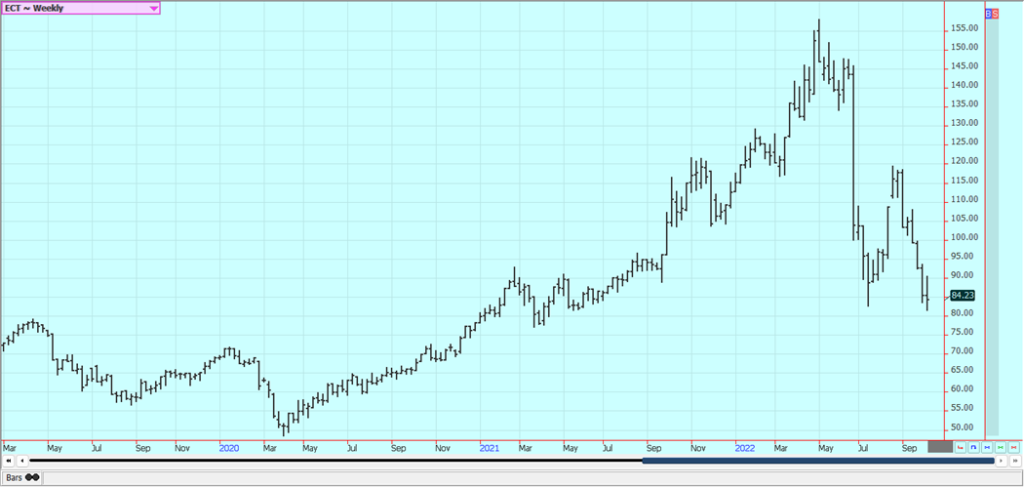
Frozen Concentrated Orange Juice and Citrus: FCOJ was higher last week as the major hurricane that moved onshore Florida last week left extensive damage but has already been factored into the prices. The weather remains generally good for production around the world for the next crop but not for production areas in Florida that have been impacted in a big way by the storm. Brazil has some rain and conditions are rated good. More showers are in the forecast for the coming days. Florida damage is expected to be very big, with many trees lost as well as fruit lost. Mexican areas are showing mixed trends, with dry weather in some northern areas but better weather to the south.
Weekly FCOJ Futures

Coffee: New York and London closed a little higher on Friday, but lower for the week on what appeared to be new speculative selling on ideas and reports of improving growing conditions in Brazil. Small offers in Arabica are reported from Brazil. There is a threat for a third year of La Nina which could negatively affect Coffee production again next year. Some beneficial precipitation was reported in Brazil last week. More showers and rains are in the forecast in Brazil Coffee areas for the coming week. Vietnam has also been dry and wire reports from there indicate that production losses are likely. Some rains were seen in Vietnam last week. The cash market remains strong for Arabica and the demand for certified stocks from the exchange remains a price-positive factor.
Weekly New York Arabica Coffee Futures
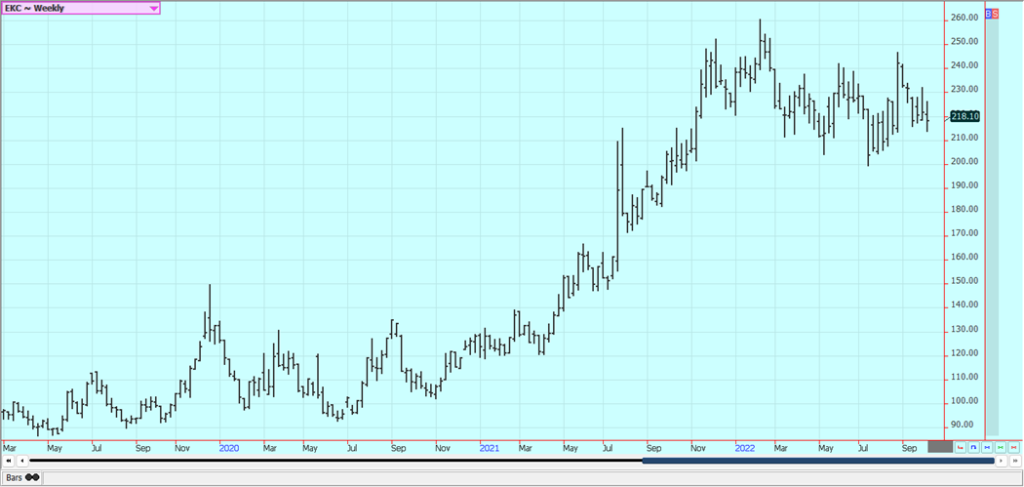
Weekly London Robusta Coffee Futures
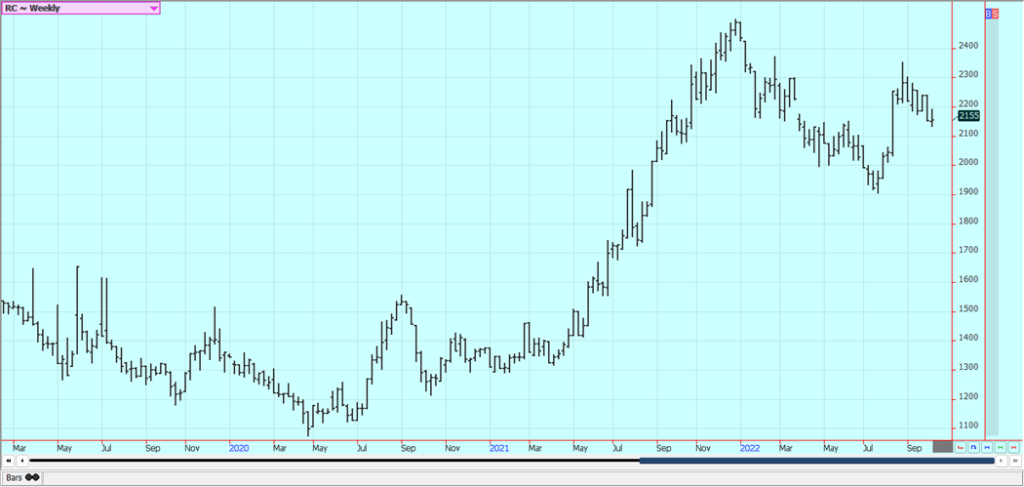
Sugar: New York and London closed higher on Friday and for the week along with rallies in Crude Oil. Crude Oil was higher on news reports that OPEC and Russia would institute a production cut to keep prices elevated. Ethanol demand should increase and the pricing power of the mills can increase. The New York market had been worried that reduced ethanol demand due to taxing policies in Brazil will force mills down there to continue to produce more Sugar for export and Crude Oil futures have been weaker until recently. The Brazilian president has lowered the fuel taxes in Brazil, and this is squeezing the profit margins of the mills. The mills could produce much more Sugar over time due to the tax changes but so far have not produced enough to meet the demand. The London market had been looking for increased White Sugar supplies from origin. Indian White Sugar exports have so far not been enough to meet the demand.
Weekly New York World Raw Sugar Futures
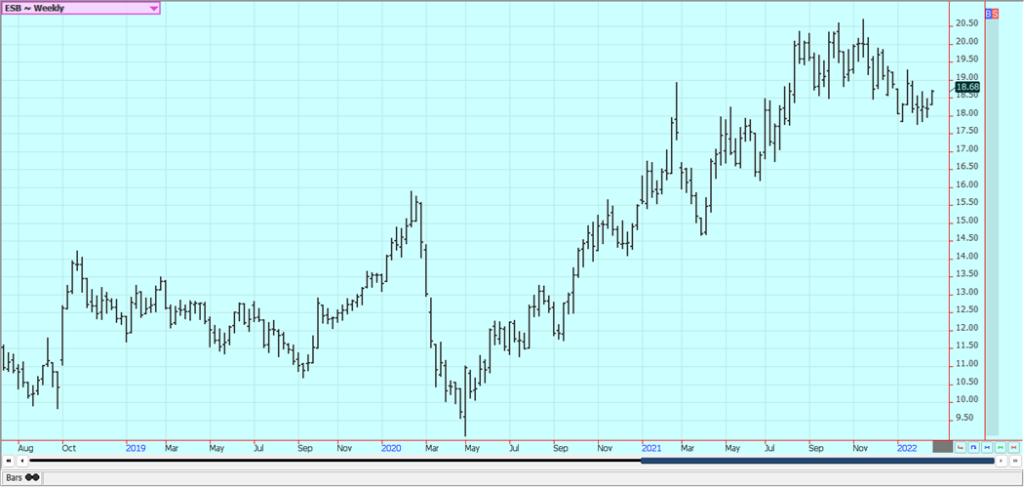
Weekly London White Sugar Futures

Cocoa: New York and London closed higher last week, with London the stronger market due to weakness in the British Pound. Ideas of big production and uncertain demand are still around but reports from Africa indicate that demand has improved lately. Reports indicate that buyers of Cocoa have enough coverage for now and can afford to wait for lower prices to develop but the buy side of the market might be waiting too long to extend coverage. Supplies of Cocoa are as large as they will be now for the rest of the marketing year. Reports of scattered showers along with very good soil moisture from showers keep big production ideas alive in Ivory Coast. Ideas are still that good production is expected from West Africa for the year. The weather is good in West Africa. The weather is good in Southeast Asia. Ivory Coast now estimates Cocoa production at about 2.2 million tons, up about 2% from last year but Nigeria now expects to produce 270,000 tons of Cocoa, down from previous estimates of 275,000 tons.
Weekly New York Cocoa Futures
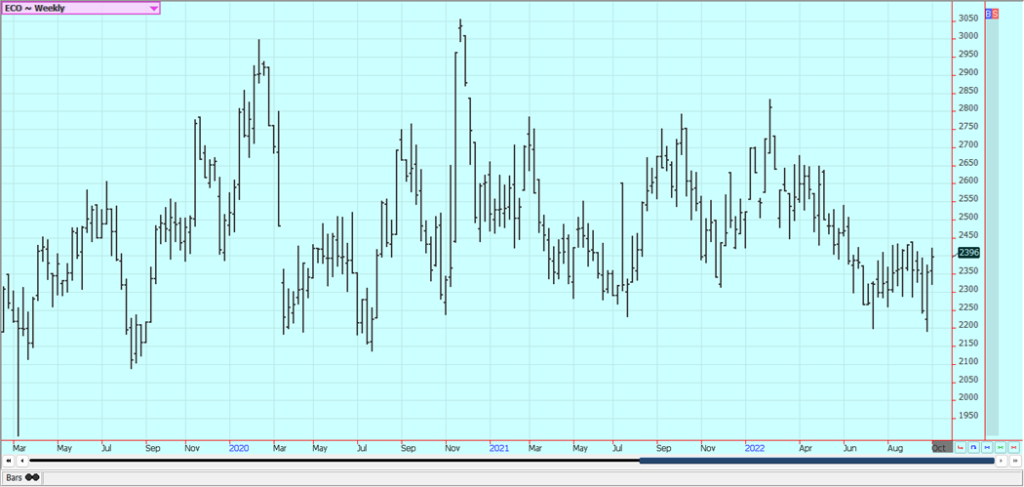
Weekly London Cocoa Futures
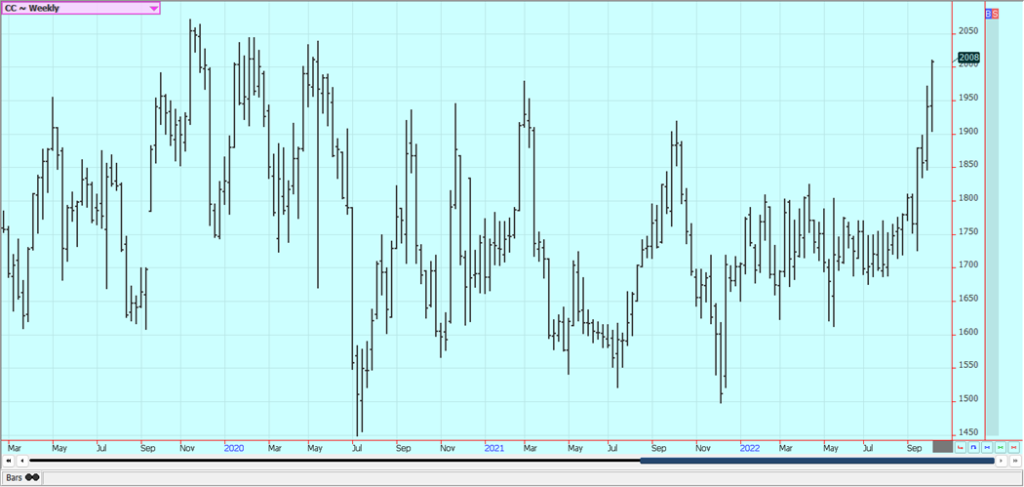
__
(Featured image by Karl Wiggers via Unsplash)
DISCLAIMER: This article was written by a third party contributor and does not reflect the opinion of Born2Invest, its management, staff or its associates. Please review our disclaimer for more information.
This article may include forward-looking statements. These forward-looking statements generally are identified by the words “believe,” “project,” “estimate,” “become,” “plan,” “will,” and similar expressions. These forward-looking statements involve known and unknown risks as well as uncertainties, including those discussed in the following cautionary statements and elsewhere in this article and on this site. Although the Company may believe that its expectations are based on reasonable assumptions, the actual results that the Company may achieve may differ materially from any forward-looking statements, which reflect the opinions of the management of the Company only as of the date hereof. Additionally, please make sure to read these important disclosures.
Futures and options trading involves substantial risk of loss and may not be suitable for everyone. The valuation of futures and options may fluctuate and as a result, clients may lose more than their original investment. In no event should the content of this website be construed as an express or implied promise, guarantee, or implication by or from The PRICE Futures Group, Inc. that you will profit or that losses can or will be limited whatsoever. Past performance is not indicative of future results. Information provided on this report is intended solely for informative purpose and is obtained from sources believed to be reliable. No guarantee of any kind is implied or possible where projections of future conditions are attempted. The leverage created by trading on margin can work against you as well as for you, and losses can exceed your entire investment. Before opening an account and trading, you should seek advice from your advisors as appropriate to ensure that you understand the risks and can withstand the losses.

-

 Fintech5 days ago
Fintech5 days agoRipple and Mercado Bitcoin Expand RWA Tokenization on XRPL
-

 Crypto2 weeks ago
Crypto2 weeks agoBitcoin Traders on DEXs Brace for Downturn Despite Price Rally
-

 Impact Investing2 days ago
Impact Investing2 days agoItaly’s Electric Cars Market Rebounds, but 2030 Targets Remain Elusive
-

 Crowdfunding1 week ago
Crowdfunding1 week agoFrom Confiscation to Cooperation: Funding Casa de la PAZ’s Social Transformation






